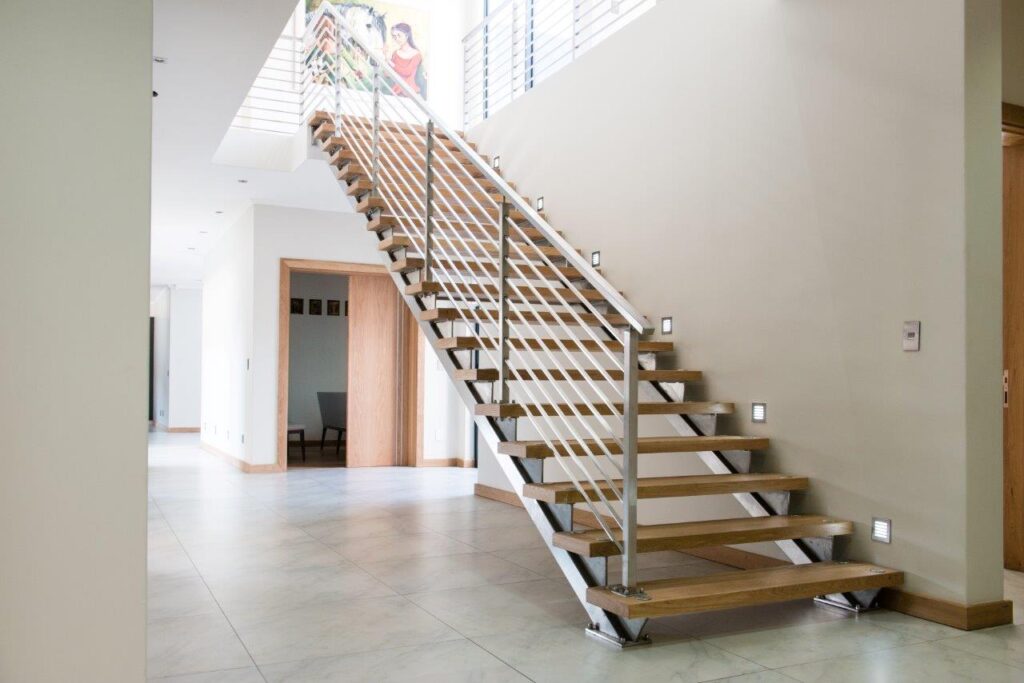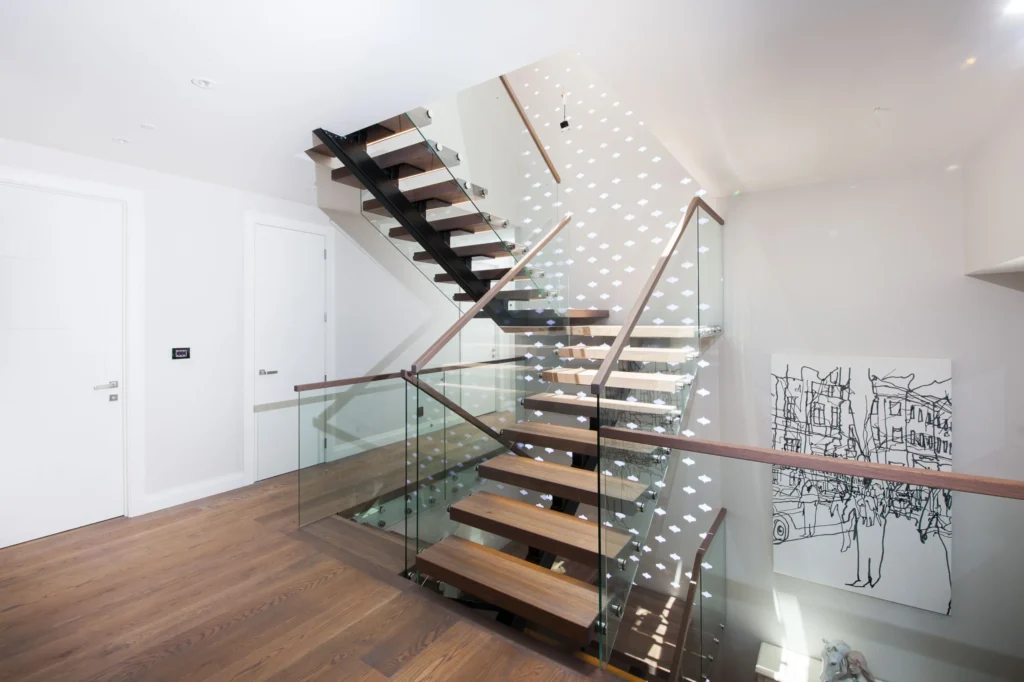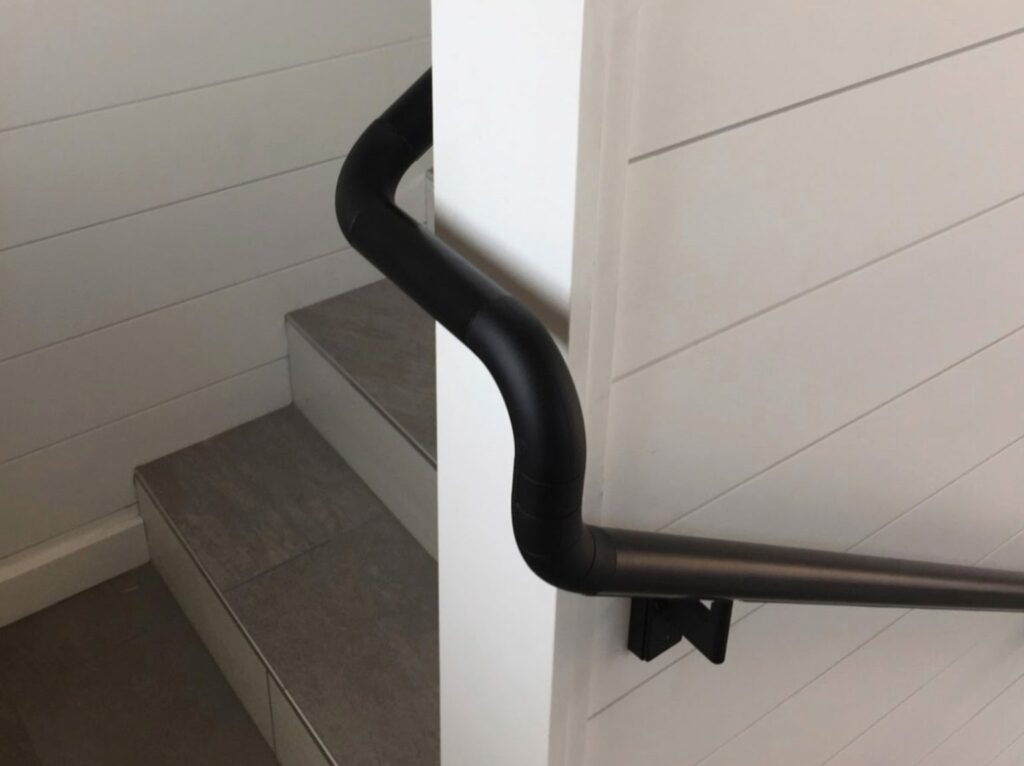
Handrail installation safety codes play a key role in ensuring the safety and accessibility of staircases and walking surfaces. These codes, such as those outlined in the International Building Code (IBC), International Residential Code (IRC), and OSHA regulations, are designed to prevent fall hazards and enhance security for everyone.
Whether it involves stair rail systems installed in homes or businesses, Compliance with these standards is essential to avoid liability issues and protect users from harm. Key aspects include the proper handrail height, the minimum clearance between the rail and wall, and ensuring guardrails are in place for stairs with four or more risers.
Professionals follow these codes closely, working with inspectors to meet the requirements of the International Code Council (ICC) and OSHA mandates. It’s all about building safety and confidence, so let’s start understanding these critical guidelines!
Importance Of Adhering To Safety Code Regulations
Adhering to safety code regulations is essential for creating environments that prioritize public well-being. These codes are carefully designed to minimize hazards and reduce the likelihood of accidents, particularly in areas such as staircases where falls are common. For property owners and builders, Compliance helps avoid costly legal liabilities and potential penalties associated with code violations.
Furthermore, adherence to safety standards ensures that all individuals, including those with disabilities, can safely and comfortably access spaces, promoting inclusivity. By meeting these regulations, property developers demonstrate their commitment to high-quality, safe designs, which can enhance trust and reputation within communities.
Conversely, non-compliance can have severe consequences, including accidents, injuries, and even fatalities. Whether for residential, commercial, or industrial structures, following safety codes safeguards both users and the integrity of the building. Regular inspections and updates to meet changing standards are critical as codes evolve to address new challenges and advanced technologies.
Key Handrail Height And Spacing Requirements

Handrail height and spacing requirements are fundamental elements of safety codes, reducing risks and providing effective support for users. According to the International Building Code (IBC), handrail heights must typically fall between 34 and 38 inches, measured vertically from the stair tread’s leading edge. This standardized range strikes a balance, ensuring the rail is easily accessible for most individuals while maintaining a secure grip.
Additionally, spacing between the handrail and the adjacent wall must be at least 1.5 inches to allow a hand to wrap around the rail without obstruction. These specifications are crucial for preventing accidents, especially in emergency scenarios where stability is key. For guardrails on balconies or landings, a minimum height of 42 inches is often mandated to avoid falls from elevated surfaces.
It’s important to work with licensed professionals to ensure these requirements are consistently met, as handrails that deviate from the code can compromise safety and lead to non-compliance penalties. Proper installation of handrails isn’t just regulatory—it’s a critical investment in preventing injuries and creating secure spaces for all.
Role of ICC and OSHA in Handrail Standards
The International Code Council (ICC) and the Occupational Safety and Health Administration (OSHA) play significant roles in establishing and enforcing handrail standards, ensuring public safety and workplace compliance. Through its International Building Code (IBC), the ICC provides guidelines that dictate handrail design, height, and spacing requirements for residential and commercial buildings.
These codes are widely adopted to regulate construction practices, focusing on minimizing fall hazards and enhancing accessibility for people of all ages and abilities. On the other hand, OSHA focuses on workplace environments, emphasizing handrails as a critical safety measure to protect workers from injuries caused by falls, trips, or slips.
OSHA standards outline minimum widthrequirements for handrail installations in areas like staircases, platforms, and walkways at job sites, ensuring these structures are robust and effective in supporting worker safety. Compliance with both ICC and OSHA standards prevents accidents and avoids legal penalties and liabilities.
Guardrail Specifications for Staircases with More Risers

Guardrail specifications are essential for staircases with four or more risers to ensure safety and meet building code requirements. According to the International Building Code (IBC), guardrails must be installed alongside staircases to prevent falls and provide support during ascent or descent. The height of these guardrails is typically required to be at least 42 inches, measured vertically from the leading edge of the staircase tread.
This ensures adequate protection for users, particularly in high-traffic or multi-story facilities. Baluster spacing is another vital aspect, as the gap between balusters should not exceed 4 inches to prevent children or small objects from passing through. The guardrail materials must also possess sufficient strength to withstand pressure or force, emphasizing the importance of durable and quality craftsmanship.
Where applicable, OSHA also requires guardrails for workplace staircases, enforcing similar standards for structure and safety. Proper adherence to guardrail specifications protects users and ensures Compliance with local building codes, making staircases a secure part of any structure.
Common Liability Issues From Code Non-Compliance
Failure to comply with building code requirements for staircases and OSHA requires guardrails, whichcan lead to numerous liability issues. Non-compliance often results in accidents such as slips, trips, or falls, which can cause significant injuries. Property owners or contractors may be held legally responsible in such cases, incurring costly lawsuits or insurance claims.
For example, if guardrails are not installed at the correct height or their spacing does not meet regulations, they may fail to provide proper protection, endangering users. Fatalities or severe injuries caused by these oversights can lead to penalties, damaged reputations, and loss of business opportunities, particularly for commercial property owners.
Further, inadequate materials or poor-quality artistry can compromise the structural integrity of guardrails, increasing the risk of collapse or malfunction. Ignoring updates in building codes or failing to have installations inspected by certified professionals compounds these risks.
Tools And Materials For Proper Handrail Installation
Successfully installing handrails requires specific tools and high-quality materials to ensure safety and durability. Common tools include a level, measuring tape, power drill, and saw, which are essential for precision and accuracy during installation. Anchoring hardware such as screws, brackets, and wall anchors is necessary for securely fastening the handrails.
Safety equipment like gloves, goggles, and hearing protection should also be used to prevent accidents. Sturdy options such as stainless steel, wood, or aluminum are popular for materials due to their strength and aesthetic appeal. Stainless steel, for example, provides excellent durability and resistance to corrosion, making it ideal for indoor and outdoor applications.
Wood offers a classic look but requires proper treatment to prevent moisture damage. Aluminum is lightweight yet robust, perfect for easy handling and secure assembly. A high-quality finish, such as a powder coating or sealant, can enhance the railings’ durability and appearance. Properly investing in tools and materials ensures code compliance and extends the handrail’s longevity.
Inspection Procedures To Ensure Code Compliance
Conducting thorough inspection procedures is essential to guarantee that handrails meet building code requirements. Review local building codes to ensure height, spacing, and structural integrity specifications are followed during installation. Inspections should include verifying that the handrail is securely anchored to the wall or structure, with no loose connections, which could create a safety hazard.
Please pay close attention to joints and endpoints, ensuring they are smooth and do not pose a risk of injury. Additionally, any changes in elevation or transitions between staircases must include handrails for consistent Compliance with codes. Test the weight-bearing capacity of the railings to confirm they are strong enough to withstand regular use and meet safety standards.
For outdoor OSHA handrails, inspect for signs of environmental damage, such as corrosion or deterioration caused by exposure to moisture or extreme temperatures. By promptly addressing any deviations or potential weak points, you can ensure the long-term safety and functionality of the handrail system, keeping it in line with all code requirements.
Maintaining Safety Over Time Through Regular Inspections
Ensuring the lasting safety of handrail systems requires routine inspections and maintenance over time. Regularly check for visible signs of wear and tear, such as rust on metal railings, cracking or splitting in wooden rails, or loose fixtures. Environmental factors, such as rain, snow, or UV light exposure, can accelerate deterioration, particularly in outdoor applications, making periodic assessments even more critical.
Inspecting the structural integrity of mounting brackets and fasteners is crucial, as these components are the backbone of the handrail’s security. Tighten any loose screws or replace damaged anchors to prevent instability. Additionally, clean the railings frequently to remove debris, which can mask potential issues.
For coated or treated materials, reapply protective finishes to maintain durability and appearance. Implementing a regular inspection schedule, such as quarterly or biannually, ensures that potential hazards are identified and resolved before they escalate. By staying proactive in maintenance, you can extend the lifespan of the handrail system and provide consistent safety for all users.
FAQs
How often should I inspect my handrails?
Inspecting your handrails at least quarterly or every three months for routine maintenance is recommended. High-traffic areas or harsher environments might require more frequent checks. Regular inspections help to quickly identify wear, damage, or instability before they become safety risks. Be thorough in assessing all components, including handrail bracketsand fasteners. A proactive approach ensures both safety and a longer lifespan for the handrails.
What materials require the most maintenance?
Wooden handrails and untreated metals typically need the most upkeep due to their susceptibility to environmental damage. Wood may crack or warp if not properly sealed, and metal can corrode without protective coatings. Regular cleaning and applying finishes or treatments help mitigate these issues. Composite or stainless steel options often require less frequent maintenance while offering durability. Always choose materials suited to your specific environment and use case.
Can I repair a handrail myself, or do I need professional help?
Minor issues like tightening loose screws or reapplying protective coatings can usually be managed with basic tools and knowledge. However, structural damage such as severe rust, cracks, or compromised fasteners may require a professional. Professionals ensure that repairs are executed to code and maintain the handrail’s safety standards. If in doubt about the extent of damage, seek professional advice to avoid any potential hazards.
What is the best way to clean and maintain handrails?
For general cleaning, use a mild detergent and a damp cloth to remove dirt and debris. Avoid abrasive cleaners, as they may damage finishes or scratch surfaces. For metal handrails, ensure the cleaning product is rust-safe, while wood may require periodic resealing or staining. Inspect and maintain protective coatings periodically to shield the material from environmental wear. Regular cleaning not only maintains appearance but also extends the handrail’s durability.
Conclusion
I hope this guide has given you the essential knowledge to properly care for and maintain your handrails. Regular cleaning, timely repairs, and periodic inspections are key to ensuring their safety, durability, and aesthetic appeal. By addressing minor issues promptly and seeking professional assistance for structural concerns, you can prevent potential hazards and preserve the quality of your handrails for years to come.
Remember to choose appropriate cleaning agents and maintain protective coatings to guard against environmental damage. With a little effort and attention, well-maintained handrails can continue to be a reliable and attractive feature of your space, providing functionality and peace of mind. Thank you for taking the time to prioritize the care of these essential elements in your home or workplace.
